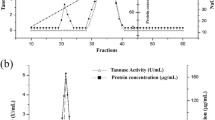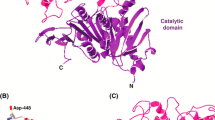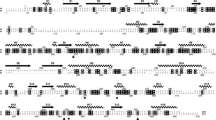Abstract
A tannase with a molecular mass of 72 kDa was obtained from Penicillium herquei isolated from valonia acorns following fermentation in a 5 L bioreactor. This tannase showed optimum activity at pH 6.0 and 30°C. The enzyme was inhibited by Fe3+, Zn2+, dithiothrietol (DTT), β-mercaptoethanol, formaldehyde, and ethanol, and induced by K+, Mn2+, Tween 80, and Triton X-100. The Michaelis constant (K m) and the second-order constant (k cat/K m) values of the tannase for propyl gallate (PG) were 0.62 mM and 174.1 mM/sec. The circular dichroism (CD) spectra indicated that the secondary structure of the tannase contained 14% α helix, 32.4% anti-parallel β-sheet, 4.8% β-sheet, 18.8% β-turn, and 30% random coil. Native tannase in ultrapure water manifested as spherical nano-particle aggregates with diameters ranging from 50 to 300 nm determined by atomic force microscopy (AFM).
Similar content being viewed by others
References
Sabu, A., A. Pandey, M. J. Daud, and G. Szakacs (2005) Tamarind seed powder and palm kernel cake: two novel agro residues for the production of tannase under solid state fermentation by Aspergillus niger ATCC 16620. Biores. Technol. 96: 1223–1228.
Belmares, R., J. C. C. Esquivel, R. R. Herrera, A. R. Coronel, and C. N. Aguilar (2004) Microbial production of tannase: An enzyme with potential use in food industry. Lebensm. Wiss. Technol. 37: 857–864.
Yu, X. and Y. Li (2006) Kinetics and thermodynamics of synthesis of propyl gallate by mycelium-bound tannase from Aspergillus niger in organic solvent. J. Mol. Catal. B Enzym. 40: 44–50.
Kumar, B., J. Sharma, and R. Singh (2007) Production of tannase from Aspergillus ruber under solid-state fermentation using jamun (Syzygium cumini) leaves. Microbiol. Res. 162: 384–390.
Lekha, P. K. and B. K. Lonsane (1997) Production and application of tannin acyl hydrolase: State of the art. Adv. Appl. Microbiol. 44: 215–260.
Vaquero, I., A. Marcobal, and R. Munoz (2004) Tannase activity by lactic acid bacteria isolated from grape must and wine. Int. J. Food Microbiol. 96: 199–204.
Aguilar, C. N. and G. Gutierrez-Sanchez (2001) Review: Sources, properties, applications and potential uses of tannin acyl hydrolase. Food Sci. Technol. Int. 7: 373–383.
Nuero, O. M. and F. Reyes (2002) Enzymes for animal feeding from Penicillium chrysogenum mycelia wastes from penicillin manufacture. Lett. Appl. Microbiol. 34: 413–416.
Mondal, K. C., D. Banerjee, R. Banerjee, and B. R. Pati (2001) Production and characterization of tannase from Bacillus cereus KBR9. J. Gen. Appl. Microbiol. 47: 263–267.
Pepi, M., L. R. Lampariello, R. Altieri, A. Esposito, G. Perra, M. Renzi, A. Lobianco, A. Feola, S. Gasperini, and S. E. Focardi (2010) Tannic acid degradation by bacterial strains Serratia spp. and Pantoea sp. isolated from olive mill waste mixtures isolated from olive mill waste mixtures. Int. Biodeterior. Biodegrad. 64: 73–80.
Aguilar, C. N., R. Rodriguez, G. Gutierrez-Sanchez, C. Augur, E. Favela-Torres, L. A. Prado-Barragan, A. Ramirez-Coronel, and J. C. Contreras-Esquivel (2007) Microbial tannases: Advances and perspectives. Appl. Microbiol. Biotechnol. 76: 47–59.
Raama, N., B. Mahendran, C. Jaganathan, S. Sukumar, and V. Chandrasekaran (2010) Optimisation of extracellular tannase production from Paecilomyces variotii. World J. Microbiol. Biotechnol. 26: 1033–1039.
Huang, W., J. Ni, and A. J. L. Borthwick (2005) Biosynthesis of valonia tannin hydrolase and hydrolysis of valonia tannin to ellagic acid by Aspergillus SHL 6. Proc. Biochem. 40: 1245–1249.
Trevino-Cueto, B., M. Luis, J. C. Contreras-Esquivel, R. Rodriguez, A. Aguilera, and C. N. Aguilar (2007) Gallic acid and tannase accumulation during fungal solid state culture of a tanninrich desert plant (Larrea tridentata Cov.). Biores. Technol. 98: 721–724.
Batra, A. and R. K. Saxena (2005) Potential tannase producers from the genera Aspergillus and Penicillium. Proc. Biochem. 40: 1553–1557.
Iibuchi, S., Y. Minoda, and K. Yamada (1968) Studies on tannin acyl hydrolase of microorganism Part III. Purification of enzyme and some properties of it. Agric. Biol. Chem. 32: 803–809.
Kasieczka-Burneck, M., K. Karina, H. Kalinowska, M. Knap, and M. Turkiewicz (2007) Purification and characterization of two cold-adapted extracellular tannin acyl hydrolases from an Antarctic strain Verticillium sp. P9. Appl. Microbiol. Biotechnol. 77: 77–89.
Sharma, S., T. K. Bhat, and R. K. Dawra (2000) A spectrophotometric method for assay of tannase using rhodanine. Anal. Biochem. 279: 85–89.
Bradford, M. M. (1976) A rapid and sensitive method for the quantification of microgram quantities of protein utilizing the principle of protein dye binding. Anal. Biochem. 72: 248–254.
Iwamoto, K., H. Tsuruta, Y. Nishitaini, and R. Osawa (2008) Identification and cloning of a gene encoding tannase (tannin acylhydrolase) from Lactobacillus plantarum ATCC 14917T. Syst. Appl. Microbiol. 31: 269–277.
Hatamoto, O., T. Watarai, M. Kikuchi, K. Mizusawa, and H. Sekine (1996) Cloning and sequencing of the gene encoding tannase and a structural study of the tannase subunit from Aspergillus oryzae. Gene 175: 215–221.
Zhong, X., L. Peng, S. Zheng, Z. Sun, Y. Ren, M Dong, and A. Xu (2004) Secretion, purification, and characterization of a recombinant Aspergillus oryzae tannase in Pichia pastoris. Protein Expr. Purif. 36: 165–169.
Barthomeuf, C., F. Regerat, and H. Pourrat (1994) Production, purification and characterization of a tannase from Aspergillus niger LCF 8. J. Ferment. Bioeng. 77: 320–323.
Sharma, S., L. Agarwal, and R. K. Saxena (2008) Purification, immobilization and characterization of tannase from Penicillium variable. Biores. Technol. 99: 2544–2551.
Rajakumar, G. S. and S. C. Nandy (1983) Isolation, purification, and some properties of Penicillium chrysogenum tannase. Appl. Environ. Microbiol. 46: 525–527.
Mahapatra, K., R. K. Nanda, S. S. Bag, R. Banerjee, A. Pandey, and G. Szakacs (2005) Purification, characterization and some studies on secondary structure of tannase from Aspergillus awamori nakazawa. Proc. Biochem. 40: 3251–3254.
Sharma, S., T. K. Bhat, and R. K. Dawra (1999) Isolation, purification and properties of tannase from Aspergillus niger van Tieghem. World J. Microbiol. Biotechnol. 15: 673–677.
Mahendran, B., N. Raman, and D. J. Kim (2006) Purification and characterization of tannase from Paecilomyces variotii: hydrolysis of tannic acid using immobilized tannase. Appl. Microbiol. Biotechnol. 70: 444–450.
Curiel, J. A., H. Rodriguez, I. Acebron, J. M. Mancheno, B. de las Rivas, and R. Munoz (2009) Production and physicochemical properties of recombinant Lactobacillus plantarum tannase. J. Agric. Food Chem. 57: 6224–6230.
Chatterjee, R., A. Dutta, R. Banerjee, and B. C. Bhattacharyya (1996) Production of tannase by solid-state fermentation. Bioproc. Eng. 14: 159–162.
Ramirez-Coronel, M. A., G. Viniegra-Gonzalez, A. Darvill, and C. Augur (2003) A novel tannase from Aspergillus niger with â-glucosidase activity. Microbiol. 149: 2941–2946.
Kar, B., R. Banerjee, and B. C. Bhattacharyya (2003) Effect of additives on the behavioural properties of tannin acyl hydrolase. Proc. Biochem. 38: 1285–1293.
Sabu, A., S. G. Kiran, and A. Pandey (2005) Purification and characterization of tannin acyl hydrolase from Aspergillus niger ATCC 16620. J. Food Technol. Biotechnol. 43: 133–138.
Rodriguez, H., B. de las Rivas, C. Gomez-Cordoves, and R. Munoz (2008) Characterization of tannase activity in cell-free extracts of Lactobacillus plantarum CECT 748T. Int. J. Food. Microbiol. 121: 92–98.
Battestin, V. and G. A. Macedo (2007) Effects of temperature, pH and additives on the activity of tannase produced by Paecilomyces variotii. Electron. J. Biotechnol. 10: 191–199.
Bhardwaj, R., B. Singh, and T. K. Bhat (2003) Purification and characterization of tannin acyl hydrolase from Aspergillus niger MTCC 2425. J. Basic Microbiol. 43: 449–461.
Farias, G. M., C. Gorbea, J. R. Elkins, and G. J. Griffin (1994) Purification, characterization, and substrate relationships of the tannase from Cryphonectria parasitica. Physiol. Mol. Plant Pathol. 44: 51–63.
Kelly, S. M. and N. C. Price (2000) The use of circular dichroism in the investigation of protein structure and function. Curr. Protein Pept. Sci. 1: 349–384.
Liu, X., X. Xu, J. Chen, W. Liu, and Q. Liu (2005) Effects of metal ions and an inhibitor on the fluorescence and activity of acutolysin A from Agkistrodon acutus venom. Indian J. Biochem. Biophys. 42: 100–105.
Gaczynska, M. and P. A. Osmulski (2008) AFM of biological complexes: what can we learn? Curr. Opin. Colloid Interface Sci. 13: 351–367.
Author information
Authors and Affiliations
Corresponding authors
Additional information
Two authors contributed equally to this work.
Rights and permissions
About this article
Cite this article
Qiu, Y., Niu, H., Huang, W. et al. Properties and secondary structure of tannase from Penicillium herquei . Biotechnol Bioproc E 16, 858–866 (2011). https://doi.org/10.1007/s12257-011-0123-6
Received:
Revised:
Accepted:
Published:
Issue Date:
DOI: https://doi.org/10.1007/s12257-011-0123-6




